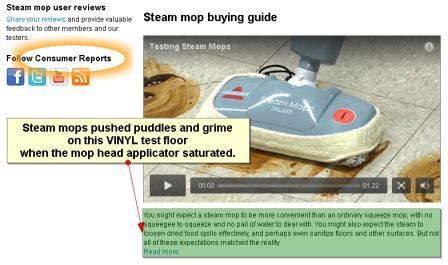Not So Hot Steam Mops
Steam mops failed to beat wring mops in a major consumer agency's side by side testing on this heavily soiled vinyl floor. Both mops introduce way too much moisture to a wood floor surface.

I'd encourage you to watch the video. It really puts the focus of our discussion where it should be in the real world--
not on the steam, but the mop's applicator, which is low grade microfiber.
High quality microfiber mops are how to clean hardwood floors, even sanitize hardwood floors without risk of water damage.
Steam Mops are Damp Mops
Boiling water is just another way of dispersing and dispensing it.
The most salient point of the video is that the water has to go somewhere
and with a saturated mop head applicator, that means steamed water is pushed past the applicator to the floor, itself.
Puddles form with no absorbency left in the mop to pick it back up.
May Cloud Your Finish
More and more people are arriving at the conclusion that the best wood floor finish for them is NOT a polymerized top coating.
A polymerized top coat is the only type of finish shown
in the infomercials.
If your floor is protected with a soft wax, expect excess moisture to cloud the surface much like a cup will leave a ring on fine furniture.
May Gray Your Wood
Hardening oils and penetrating oils are two other floor finishes gaining in popularity. If either of these are your floor finish, you won't have
the clouding issue. These products are not left on the surface to discolor.
But your wood might turn gray. That's how wood responds naturally to excess moisture.
You chose a hardening oil or penetrating oil for its natural and forgiving qualities, so you are not shocked by this and understand that
if you do steam, it may simply mean re-oiling a little more often.
The Wood Floor Conservancy's guidance on how to clean hardwood floors:
- cleaning must be easy, or it might not get done often enough
- cleaning must be inexpensive, or it might not get done at all
- cleaning must leave no residues that attract more dirt
- cleaning must require minimal moisture, if any.
Return to How to Clean Hardwood Floors from Steam Mops
Made possible, in part, by:
 School of Lower Learning
School of Lower Learning



New! Comments
Have your say about what you just read! Leave me a comment in the box below.